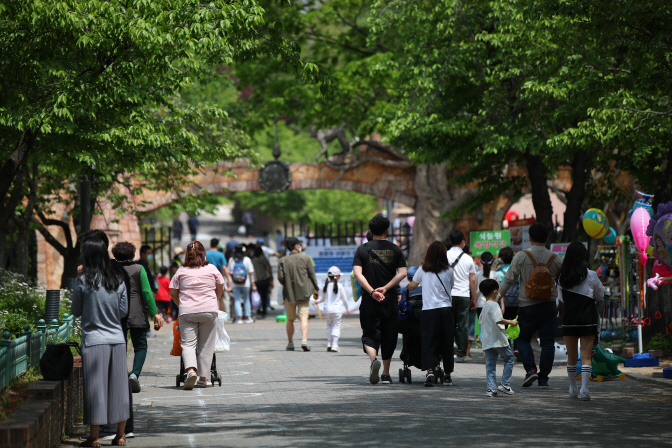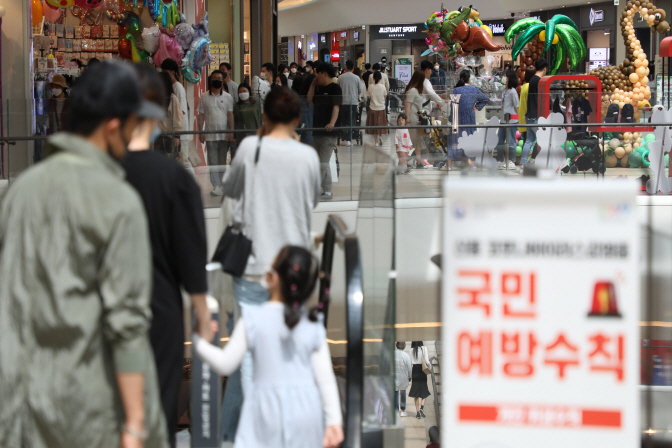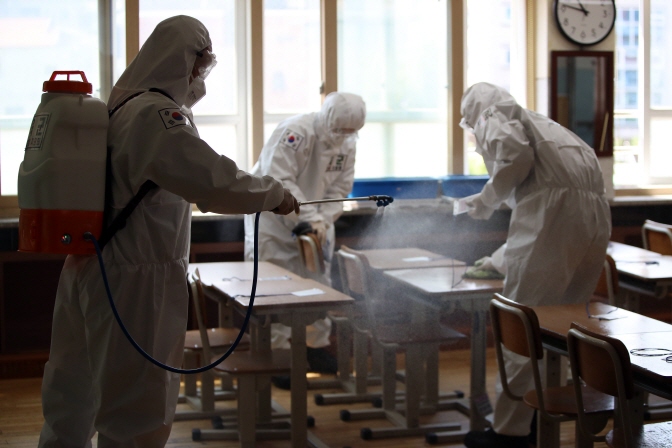
This photo, taken on May 3, 2020, shows citizens at a zoo inside Children’s Grand Park in Seoul. (Yonhap)
SEOUL, May 4 (Korea Bizwire) — After successfully flattening the coronavirus curve, South Korea is transiting this week to a quarantine scheme that allows citizens to return to their daily routines under eased guidelines.
But health authorities are still wary of “blind spots” in the fight against the virus — cluster infections and imported cases.
Starting Wednesday, South Korea will implement an “everyday life quarantine” system, allowing people to engage in a certain level of economic and social activities while maintaining a distance to slow the spread of the novel coronavirus.
Since March 22, the country has implemented strict social distancing guidelines urging citizens to stay home, except for essential needs or jobs, while strongly recommending people suspend religious gatherings, indoor sports activities, and visits to nightclubs and other entertainment venues.
On the back of such strong quarantine measures without lockdowns, South Korea was able to contain new virus infections after peaking at 909 on Feb. 20. The country confirmed its first COVID-19 case, a Chinese woman, on Jan. 20.
South Korea’s transition to the new quarantine scheme comes after the country reported clear signs of a slowdown in new virus cases.
Since April 9, the country’s daily virus infections have been under 50. In particular, the number of new cases has been below 20 for more than two weeks, with zero local infections reported on three different days.
As of Monday, the country’s total virus cases stood at 10,801, according to the Korea Centers for Disease Control and Prevention (KCDC), but 85 percent of them have recovered from the disease and were released from quarantine.

This photo taken on May 3, 2020, shows people at a shopping mall in Goyang, north of Seoul. (Yonhap)
The new quarantine system allows people to take part in outdoor activities and mass-gathering events under the conditions that virus prevention measures are carried out.
The government last month revealed hygiene guidelines on 31 areas, covering almost every situation that people would face in their daily lives.
The guidelines, confirmed Sunday after weeks of discussions, call for people to stay home if they show symptoms of COVID-19, such as a fever, or have gone overseas in the past two weeks.
Regardless of place, people are advised to keep a distance of 2 meters when they meet others and to follow basic personal hygiene routines, such as washing their hands and wearing masks.
“It means that each individual and our society will have to be responsible for containing the virus,” Vice Health Minister Kim Ganglip said during a press briefing Monday.
“It is not about the country going back to where it was before the COVID-19 outbreak. It is about making new norms and culture.”
The government said earlier it would switch to the everyday life quarantine system if the number of daily new virus cases fell below 50 and the portion of patients with unknown infection routes dropped below 5 percent.
Infections from unidentified routes accounted for 6.3 percent of the new cases reported in the last two weeks.
“Moving to the everyday life quarantine system means that the government has showed its confidence in controlling the novel coronavirus crisis,” said Kim Woo-joo, a professor of infectious medicine at Korea University Guro Hospital in Seoul.
“With the number of new infections falling sharply and most cases being identified under quarantine measures, health authorities appear to have evaluated its virus response positively.”
However, health authorities have vowed to stay on guard against the novel coronavirus, saying that cluster infections could emerge anytime.
“It does not mean that the COVID-19 crisis has come to an end,” said Health Minister Park Neung-hoo on Sunday. “Even if we report virus cases in communities, our goal is to stem mass infections.”

In this photo, taken on May 1, 2020, military medical soldiers disinfect a classroom at an elementary school in Daegu. (Yonhap)
Experts said the country should be aware of possible group transmission at places considered “blind spots,” such as residential space for homeless people and illegal foreign workers who are reluctant to visit medical institutions.
“It’s not that foreign workers are especially vulnerable to the virus,” said Chun Byung-Chul, an epidemiologist at Korea University.
“If there is a virus-infected person at places where many people live together in groups, the virus could spread out of control, so we should keep a watchful eye.”
Experts pointed out that nursing hospitals, where many virus-related deaths were reported, should be monitored thoroughly.
Health authorities said they plan to use pooled samples to regularly test those who are vulnerable to virus infections, so that they can better stem the “silent” spread of COVID-19.
They will also focus on quarantine measures for schools, as students are to physically attend classes later this month.
After delaying the start of the new semester, South Korea on April 9 decided to hold classes online, starting with senior high school students.
“We have set our priority on schools and will reinforce our monitoring system,” said Prime Minister Chung Sye-kyun. “If there is a warning sign, we will adjust the intensity of social distancing at anytime and will take necessary steps.”
(Yonhap)






